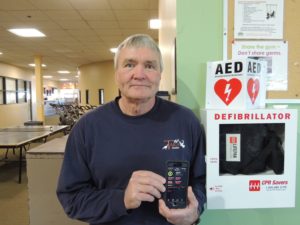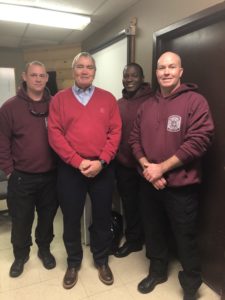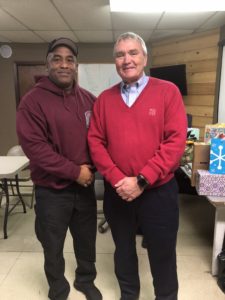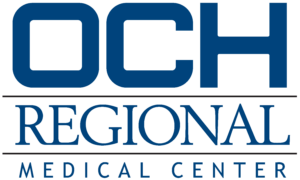If there’s ever a good place to go into cardiac arrest, Dave Bragg found it inside the OCH Healthplex, across from the Cardiac Rehab department and steps away from the automated external defibrillator (AED). Bragg said Monday, December 18 was just like any other day at the OCH Wellness Connection where he routinely rides for 20-miles on a stationary bike. 
“My smart watch shows my heartbeat [red dots] where I started riding the bike at 3:26, and at about 3:50, it goes to black. That’s when I hit the ground,” said Bragg.
What happened after the red dots ended is a story Bragg would live to tell. Starkville Firemen Ashley McClain and Brian Clark were working out at the Wellness Connection and grabbed the AED off the wall to shock Bragg’s heart and began CPR.
 About a mile down the road, OCH EMS Assistant Director Shedrick Hogan was working at the fire station when he heard the code called at the Wellness Connection. Hogan said he had just gotten back from the hospital and knew all the paramedics were out on calls.
About a mile down the road, OCH EMS Assistant Director Shedrick Hogan was working at the fire station when he heard the code called at the Wellness Connection. Hogan said he had just gotten back from the hospital and knew all the paramedics were out on calls.
“Lieutenant Harris and I jumped in the fire truck to go to the hospital, and he dropped me off at the ambulance bay,” said Hogan, who has 23 years of experience in EMS. “When I drove the ambulance to the Wellness Connection, they brought Dave out on a stretcher while doing chest compressions. I hooked him up to the cardiac monitor in the ambulance and saw that he had a shockable rhythm and was able to get a pulse. I told one of the guys to jump in the front and drive us to the hospital.”
Bragg experienced ventricular fibrillation, a cardiac rhythm disturbance that occurs when the lower chambers of the heart quiver and don’t pump blood, causing cardiac arrest.
“It was awesome that they shocked his heart so quickly because studies show early defibrillation is what saves lives. The heart is in a quivering motion so the shock helps the heart restart itself,” explained  Hogan.
Hogan.
Bragg, who is 58, had one stent put in and spent four days in the hospital. On his way home from the hospital, he made a stop by the Wellness Connection to tell everyone “thank you,” and later made a special trip to the fire department to meet the firemen who saved his life.
“The firemen are the true heroes. They’re the reason I’m still here today. I can’t thank them enough, and I couldn’t have asked for a better team to take care of me that day,” said Bragg.
Bragg now has a more sophisticated device than his smart watch to track his heart rate. He has a blue tooth defibrillator. Each night, a device on his night stand reads his defibrillator and sends a report to his cardiologists.
“It’s nothing but insurance. I don’t have the pacemaker any more, and there’s no damage to the heart that they can see,” said Bragg.
Both of Bragg’s parents passed away of congestive heart failure, and knowing he has a family history of heart disease, he’s always made a conscious effort to live an active lifestyle. In fact, every time he saw OCH Cardiac Rehab Director Jordan Vance inside the OCH Healthplex, he would joke that he was exercising to stay out of her department. Now, Bragg is one of Vance’s patients in the cardiac rehab program.
“We can work as hard as we want to, but we cannot control an anatomical problem or genetic factor. That’s why it’s so important to start at a young age and be as proactive as possible with nutrition, exercise, regular check-ups, taking medications as prescribed, avoiding risk factor behavior like smoking and sedentary lifestyles,” explained Vance.
“I never thought I’d be in cardiac rehab. That’s why I always rode the bike,” said Bragg who sometimes finds it difficult to work out at a slower pace. “Jordan always tells me, ‘don’t be in a hurry.’”
“We want him to safely get back to normal instead of just jumping back in full speed. It’s a process he has to go through to give his body time to heal and make sure his heart is safe and that he is safe,” said Vance.
OCH’s Cardiac Rehabilitation Program is a supervised education and exercise program for those who have experienced illness associated with cardiovascular disease, including chest pain, heart failure, heart attack, coronary bypass surgery, angioplasty, stents, valve surgery and heart transplant. Vance said part of the program’s goal is to help the patients and their caregivers adjust to a new lifestyle.
“It’s easy for patients to feel bombarded with medications, a new diet and exercise program, so we want to support them so that they’re not overwhelmed. We encourage them to make small changes they can stick with because many times when patients try to change everything at once, they go back to their old ways,” said Vance.
Bragg is quickly meeting his goals in cardiac rehab—he’s already maxed out the 10 pound weight on the dumbbells, 20 minutes on the treadmill, 10 minutes on the arm ergometer and now on level six out of 10 on the NuStep machine.
“Cardiac Rehab has been very helpful. They monitor you while you exercise. They told me I have to graduate before I can go back out there [Wellness Connection] and work out on the machines,” laughed Bragg. “The whole crew over here at the Healthplex is just like over at the main hospital. The staff is wonderful, and they go out of their way to help you.”
Vance said if there’s anything she wants people to take away from Bragg’s story is for people to become CPR certified or at least learn how to perform hands-only CPR.
“You can save a life by knowing how to perform CPR,” said Vance. “That is definitely what saved Dave’s life.”
To learn how to perform hands-only CPR, visit cpr.heart.org.
